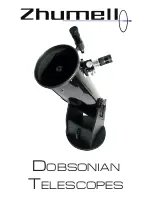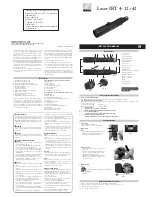
90
CHAPTER 10 - TELESCOPE MAINTENANCE
While your Ultima 2000 telescope requires little maintenance, there are a few things to remember that will
ensure your telescope performs optimally.
Care and Cleaning of the Optics
Occasionally, dust and/or moisture may build up on the corrector plate of your Ultima telescope. Special
care should be taken when cleaning any instrument so as not to damage the optics.
If dust builds up on the corrector plate, remove it with a brush (made of camel's hair) or a can of pressurized
air. When using pressurized air, spray at an angle to the corrector for approximately two to four seconds.
Then, use an optical cleaning solution and white, unscented (Kleenex type) tissue paper to remove any
remaining debris. Apply the solution to the tissue and then apply the tissue paper to the lens. Low pressure
strokes should go from the center of the corrector to the outer edge. Do NOT rub in circles!
You can use a commercially made lens cleaner or mix your own. A good cleaning solution is isopropyl
alcohol mixed with distilled water. The solution should be 60% isopropyl alcohol and 40% distilled water.
Or, liquid dish soap diluted with water (a couple of drops per one quart of water) can be used.
Occasionally, you may experience dew build-up on the corrector plate of your telescope during an
observing session. If you want to continue observing, the dew must be removed, either with a hair dryer or
by pointing the telescope at the ground until the dew has evaporated.
If moisture condenses on the inside of the corrector, place the telescope in a dust-free environment. Remove
the accessories from the rear cell and point the telescope down. This will remove the moisture from the
telescope tube.
To minimize the need to clean your telescope, replace all lens covers once you have finished using it. Since
the rear cell is NOT sealed, the cover should be placed over the opening when not in use. This prevents
contaminants from entering the optical tube.
Internal adjustments and cleaning should be done only by the Celestron repair department. If your telescope
is in need of internal cleaning, please call the factory for a return authorization number and price quote.
Collimation
The optical performance of your Celestron telescope is directly related to its collimation, the alignment of
its optical system. Your Celestron Ultima 2000 was collimated at the factory after it was completely
assembled. However, if the telescope is dropped or jarred severely during transport, it may have to be
collimated. The only optical element that may need to be adjusted, or is possible, is the tilt of the secondary
mirror.
Collimation is the alignment of the optical elements. In the Schmidt-Cassegrain optical system used in the
Ultima, this is the alignment of the primary and secondary mirrors.










































